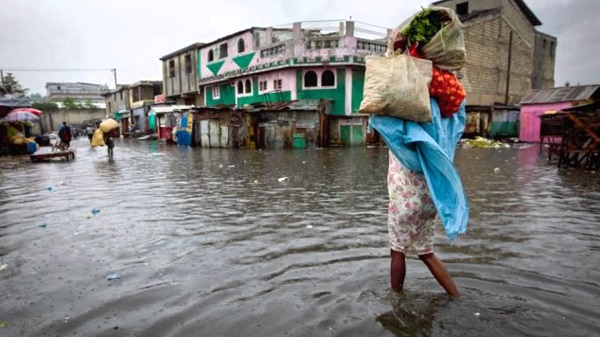The effects of Climate Change, particularly sea-level rise, is an overwhelming problem for the Caribbean that needs urgent attention. Delay in putting in place sustainable plans for resilient building, that could secure international financial support, will cost the region dearly.
The problem has become multi-faceted and addressing it requires collaboration among structural and mechanical engineers, accountants, economists, environmentalists and designers of tourism plants.
The trick is going to be how to merge defences against sea-surges and flooding with the aesthetics necessary to maintain the Caribbean as a sun, sea and sand destination.
2017 has witnessed back-to-back Category 5 hurricanes that cut a swathe through the Caribbean from which the affected islands will not fully recover for many years to come.
As an example of this, in 1994 Antigua and Barbuda received the largest number of tourists in its previous history. Then, in 1995, Category-5 Hurricane Luis battered Antigua, leaving its tourism plant in tatters. The country did not achieve its 1994 figures until 2014, twenty years later.
Importantly, the 2017 hurricanes also caused thousands of people from Barbuda and Dominica, whose homes, schools, hospitals and businesses have been decimated, to seek refuge in other islands. These people are, in effect, ‘Climate Refugees’, ripped away from their history, their culture and their identity.
Their plight has been created by ferocious storms not caused by their own actions but by profligate carbon emissions (CO2) by rich nations. And despite the 2016 Paris Accord and the follow-up Bonn meeting last month, there is no sign that these emissions will end. Indeed, even if the present level of CO2 emissions were to stop today, because of the heat that has already built-up in the atmosphere and the oceans, the seas would not stop rising until the Earth cools and that could take centuries.
The non-binding Paris agreement only expresses an objective to limit global warming to “well below 2 degrees above pre-industrial levels”. The goal of 1.5 degrees Celsius, is merely “aspirational”. In fact, the climate change action plans submitted by 188 countries would lead to a temperature rise as high as 2.7 degrees Celsius. At 3 degrees, the size of islands will shrink, productive areas will be under water, people will have to move habitats inland and many will be forced to migrate, legally and illegally.
This poses a deadly threat not only to tourism, but also to human habitats. This could cause human dislocation and create refugees who flee their homelands for safe havens. Right now, the possibility of the climate refugees from Barbuda and Dominica returning to their homes in the short to medium term is remote. For both Antigua and Barbuda and Dominica, the rebuilding prospect is daunting; they simply don’t have the money.
Worse for them is that because they are measured by the palpably false criteria of per capita income, they don’t have access to aid, grants and concessional loans. That is why countries, such as Antigua and Barbuda, must hope that Bill Gates never migrates there. For they would become the richest countries per capita overnight, but the majority of their people would have not one more cent in their pockets than they had before.
There is also no possibility of these countries rapidly rebuilding by borrowing money on commercial terms. Even if they could borrow on the commercial market, their debt would be increased to unsustainable levels with little possibility of generating enough revenues to make repayments.
Worryingly, not only has the Caribbean seen the creation of the first set of ‘climate refugees’, but the damage done to property has been so extensive that unemployment and poverty have increased. And if this development is not bad enough properties, including businesses, that were not insured or were under-insured will not be rebuilt.
Insurance companies, already faced with huge pay-outs from 2017, will increase their premiums and they will not insure buildings that do not conform to high standards of resilience. Consequently, many businesses people and home owners will not be able to afford the higher cost of insurance coverage. Yet, if they do not insure their properties substantially, financial institutions will not provide mortgages.
Complicating the issue still further, the Future Business Council and the Centre for Policy Development have recently warned Directors of Public Companies to factor climate change as a risk in business and investment decisions. Directors that fail to consider and disclose climate change risks could now be found liable for breaking their duty of care and diligence in the future. Therefore, there could be a decline in investment, particularly in the tourism sector which now accounts for an average of 60 per cent of the region’s GDP.
The problem has to be faced squarely, deferring it to another generation won’t work – the generation confronting the issue is here. With sea-level rise happening continuously but gradually (barring a sudden melting of ice caps in Antarctica and Greenland), there is still time to plan for the worse effects of Climate Change.
Caribbean countries have to demonstrate clearly that they are taking action to counter global warming and sea-level rise. Such action has to be at two levels: domestic resilient building, and international advocacy.
Domestically, each Caribbean country must implement new and tough codes for future construction and adopt legislation to ensure compliance. Governments also now need to consider the building of walls and other defences to withstand sea surges, and reservoirs to cope with flooding. All of this requires careful thinking and preparation about how to make Caribbean countries safe from sea-level rise and still attractive for tourism.
However, governments don’t have the money to fund these now necessary projects. Even if they were to tax their people and businesses, they could not possibly raise the necessary funds. That is why the richer and more profligate CO2 emitter-nations must be made to help alleviate the burden they have created and loaded onto small states.
At the international level, Caribbean countries should form alliances with other countries and regions that are similarly affected. It is unfortunate that the United States, the single largest CO2 emitter, is now unwilling to participate in the Climate Change accords. Caribbean countries, therefore, should consider making common cause with individual states of the United States, such as Florida, the Carolinas and New York, where sea-level rise could be as catastrophic as in the Caribbean.
Caribbean voices must be heard loudly in the international community, fighting for their survival. There is no time for delay.
(This commentary is excerpted from the writer’s presentation to the Caribbean Actuarial Association’s 27th annual conference in Nassau, Bahamas on 30 November 30 on Political and Economic Challenges Confronting the Caribbean)




